On the map you see two excursions into the moountains.
Click
on photo to enlarge
The photo opens in a new window - to close it: click X in upper right corner.
Days in Lefka Ori 1
|
On the map you see two excursions into the moountains. |
|
|
|
Click
on photo to enlarge
The photo opens in a new window - to close it: click X in upper right corner. |
|
|
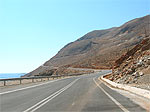 |
A ideal place to start a tour into the White Mountains - Lefka Ori, as they are called in Greek - is the village of Anopoli, a little west of and many hundreds of meters above Chora Sfakion. | |||
|
|
||||
 |
There are several possibilities for accommodation in Anopoli. Among others there is an excellent restaurant with room rental at the square. Here you can also sense the presence of history with a view to the large statue of the local hero Daskalogiannis while enjoying your food or just a cup of coffee. | |||
|
|
||||
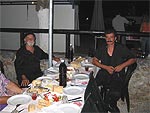 |
Arriving in mid-August, you have the opportunity to participate in the annual graviera party. The celebration symbolizes that the shepherds especially in older times returned from the mountains with the cheeses, which they had made in their mitato's (stone houses) during the summer. | |||
|
|
||||
| Immediately after the square the road splits: one leads westwards to Aradaina and Agios Ioannis and another to the north – up into the mountains. It is, by the way, signed as a bicycle route! | ||||
|
|
||||
 |
In the heart of the pine forest, where there are a lot of bee-hives, the road turns off to the right and goes upward in sharp bends. | |||
|
|
||||
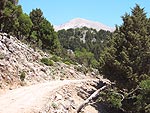 |
You'll pass a few mitato's and some 'kimite's, small stone huts where shepherds can stay overnight or quickly seek shelter in case of bad weather, when they are walking from one area to another. The word kimité is derived from the Greek verb κοιμάμαι (kimame) = to sleep. | |||
|
|
||||
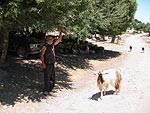 |
At
one of the mitatos Nikos
stopped me and invited
me in for a light
meal – "mezedakia"
as he said. It
turned out to be a
longer visit: After
we had eaten a lot of
fried goat meat and
drunk adequate amounts of
red wine, which I had brought from
the "civilized" areas,
we ended up at his goat
fold. Meanwhile
Nikos sung several
rizitika songs with
his awesome voice. Listen to Nikos, click here. |
|||
|
|
||||
| Some years earlier he had sung at the dedication of the bust of the archimandrite Parthenios Kelaidis in Chora Sfakion. Parthenios Kelaidis was born in Mouri in 1830 and actively participated in the rebellion 1866-69. When he was persecuted by the Turkish authorities, he fled to Italy, where he worked for a free Crete. | ||||
|
|
||||
 |
After the lunch, I took leave of Nikos and went on to Mouri. | |||
|
|
||||
 |
Now Mouri is abandoned, but in old days it was a flourishing village, as it appears from the many ruins and low walls around the fields. It is unknown when Mouri was founded, but according to the turkish census from 1834 there lived at that time 50 Christian families. The village was inhabited until 1961 – by four persons only. | |||
|
|
||||
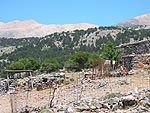 |
But you can still be lucky to meet some of the sheperds, who stay here for shorter periods, for example Pavlos or his brother Nikos, who invited me inside for graviera and raki. | |||
|
|
||||
|
They
also showed me how
a traditional cheese-making
takes place. |
||||
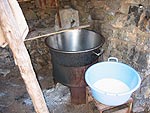 |
||||
|
|
||||
| It was in Mouri, that the shepherd Barba-Pantzelios composed his song about Daskalogiannis' unsuccessful revolt against the Turks in 1770, which is a popular song among the inhabitants of the mountains. The song, which was written down in 1786, consists of a little more than 1000 verses and begins as follows: | ||||
|
|
||||
| Θέ μου και δός μου φώτιση, καρδιά σαν το καζάνι, | ||||
| να κάτσω να συλλογιαστώ το Δάσκαλο το Γιάννη. | ||||
| Θέ μου και δός μου λογισμό και μπόρεση ν' αρχίξω | ||||
| το Δάσκαλο τον ξακουστό πρικιά να τραγουδήξω. | ||||
| Θέ μου και δός μου απομονή και νουν εις το κεφάλι | ||||
| ν' αναθιβάλω και να πω και τω Σφακιώ τα βάλη. | ||||
|
|
||||
| Dear God, give me enlightenment, a heart strong as a cauldron, | ||||
| so that I can sit and recall the teacher Giannis. | ||||
| Dear God, give me thought and ability to start | ||||
| to sing a sorrowful song about the renowned Teacher. | ||||
| Dear God, give me patience and sense in my head, | ||||
| so that I can narrate and tell about the adversities of Sfakia. | ||||
|
|
||||
| Listen to the priest Angelos Psyllakis singing an excerpt from the song (11.40 min.), click the picture to the right. | ||||
| Angelos Psyllakis, who went by the nickname Sfakianomadaritis (the one from the mountains of Sfakia), was a priest at the chuch of Agios Charalambos in Lentariana in Chania. From his childhood he was very interested in Cretan folkmusic - especially the rizitika-songs. In 1978 he and Charalambos Garganourakis recorded excerpts of the song on Daskalogiannis. Psyllakis died in 1996 and is buried in his old parish in Lentariana. | ||||
|
|
||||
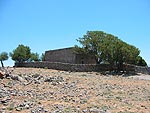 |
From Mouri a dirt road leads down to the double vesseled church of Christ and the Virgin Mary from the mid 19th century (maybe earlier). | |||
|
|
||||
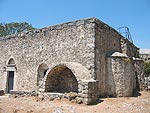 |
On the south wall of the church you see one of the arkosoli'es (old graves) that are quiet common in Sfakia area. Unfortunately, the double vesseled church has lost its curved roofs at the restoration, and the roof has been replaced with a flat concrete roof. | |||
|
|
||||
| Approximately 1 kilometre further down the road ends at a goat fold next to the gorge of Kavis. Although the area seems very desolate, goats are used to get visits, because as soon as they saw me, they came runing. | ||||
|
|
||||